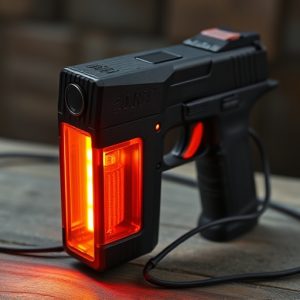Optimizing Runt Stun Gun Performance: A Guide to Understanding Voltage Impact
A runt stun gun is a compact yet effective self-defense tool, offering a range of voltage outputs f…….
A runt stun gun is a compact yet effective self-defense tool, offering a range of voltage outputs from 400,000 to over 1 million volts. Its effectiveness isn't solely based on voltage; it's also influenced by factors like microcoulomps, amperage, energy capacity, and electrode design, which together contribute to its incapacitating power in real-world situations. Users should be familiar with these specifications and practice using the device to ensure they can rely on it in emergencies. Contrary to being underpowered, runt stun guns are designed for portability and ease of use, with a 650,000-volt rating often proving sufficient for self-defense. The design and quality of components, electrode placement, and the device's delivery system are equally important for optimal performance. Legal compliance with local stun gun laws is essential, and regular maintenance is necessary to keep the runt stun gun ready for use. In a confrontation, targeting larger muscle groups with a runt stun gun can maximize its disorienting effect due to higher neuron density in these areas. Regular practice with the device ensures proficiency and confidence when using it under pressure, always considering safety and legal implications. Understanding the mechanics of a runt stun gun and its operational parameters is key to effectively employing this self-defense tool.
When considering personal safety devices, runt stun guns emerge as compact yet potent tools. Contrary to their diminutive size, these devices pack a significant punch, often raising questions about their voltage and effectiveness. This article demystifies the concept of ‘runt’ in relation to stun gun voltage, delving into the science that governs their capability. We will explore how voltage influences the performance of these devices, ensuring users can maximize their efficacy for safe and efficient use. Understanding the intricacies of runt stun gun voltage is crucial for anyone seeking reliable self-defense. Join us as we unravel the facts behind these devices and provide you with the knowledge to harness their full potential.
Understanding Runt Stun Gun Voltage: A Comprehensive Guide
When evaluating the effectiveness of a stun gun, understanding its voltage is crucial for assessing its incapacitating potential against an assailant. A runt stun gun, often perceived as less powerful due to its lower voltage compared to standard models, still packs a substantial defensive punch. Typically, stun guns are measured in terms of microcoulomps or shock amplitude rather than pure voltage, which provides a more accurate representation of their incapacitating ability. The voltage of a runt stun gun can range from 400,000 to over 1 million volts, which is sufficient to deliver a powerful electric shock. It’s important to note that the effectiveness of a stun gun is not solely determined by its voltage; factors such as amperage, energy capacity, and electrode design play significant roles in its overall performance. When using a runt stun gun for self-defense, it’s essential to understand its limitations and capabilities. Users should familiarize themselves with the device’s specifications and practice using it under controlled conditions to ensure they can respond effectively in an emergency situation. Additionally, the term ‘runt’ does not necessarily indicate a weak or ineffective tool; rather, it often refers to compact, easy-to-carry devices designed for personal safety. Understanding runt stun gun voltage involves recognizing the interplay of various electrical metrics that contribute to its functioning and efficacy. Users should select a stun gun that meets their self-defense needs, considering both its voltage and other important features.
The Science Behind Runt Stun Guns: How Voltage Affects Capability
Runt stun guns, despite their compact and concealable design, are engineered to deliver an electrical shock that can incapacitate an assailant. The effectiveness of these devices is largely dependent on their voltage output. A higher voltage can increase the potential for a more potent shock, which in turn can lead to muscle contractions and neural disruptions, rendering an attacker momentarily immobile. The science behind stun guns involves understanding how electric current interacts with the human body. When activated, the electrical charge travels through the body along nerve pathways, causing rapid muscle contractions and disorientation. The voltage of a stun gun is a critical factor in this process; it determines the intensity and reach of the electric current. Typically, stun guns are categorized by their milliampere (mA) and volt ratings. A runt stun gun that outputs around 650,000 volts can be sufficient for self-defense purposes, as this voltage level can generate a strong enough charge to produce the required muscle contractions without being overly large or conspicuous. It’s important for users to understand that while a higher voltage can enhance incapacitation potential, it is not the sole determinant of a stun gun’s effectiveness. Factors such as the design of the electrodes, the energy capacity of the battery, and the delivery mechanism also play significant roles in the device’s performance. Users should always ensure they are well-versed in the laws governing stun guns in their jurisdiction before considering these devices for personal protection.
Maximizing the Efficacy of Your Runt Stun Gun: Tips for Safe and Efficient Use
When utilizing a runt stun gun for self-defense, understanding its capabilities and limitations is crucial. The efficacy of a stun gun is not solely determined by its voltage but also by its design, the quality of its components, and proper technique during deployment. To maximize the effectiveness of your runt stun gun, ensure it’s fully charged; consistent maintenance can prevent power issues when you need it most. Additionally, familiarize yourself with the device’s features, such as the placement of the electrodes and the types of cycles it can deliver. During a confrontation, aim for the larger muscle groups like the thighs or shoulders, as this increases the stun gun’s impact due to the higher concentration of neurons in these areas, leading to muscular disruption more effectively. Remember that practice with your runt stun gun is essential; regular training helps you become adept at handling it under stress. Furthermore, always be aware of your surroundings and potential escape routes when using a stun gun, as safety is paramount. Adhering to local laws and regulations regarding the use of stun guns ensures legal compliance and responsible ownership. With proper usage and understanding of its functions, a runt stun gun can serve as a reliable deterrent in challenging situations.


